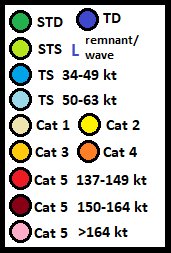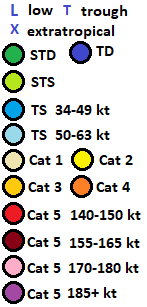Verification of tracks made of Erick using GEFS mean fields
I made two tracks of Hurricane Erick. Additionally, within
384
hours of cyclogenesis, there were seven instances, when I missed
cyclogenesis entirely.
As of this analysis, best track positions are available July 25, 18Z thru August 6, 18Z, and as such, position comparisons are possible only for this timespan.
Getting out of the frame of East Pacific tracking map is considered equal to dissipation for the purpose of this verification.
Since I give only SSHS categories in my tracks, I don't calculate intensity errors in units of speed, but in categories. For this purpose, I define tropical or subtropical storms as "Category 0", tropical or subtropical depressions as "Category -1" and non-existence of a tropical or subtropical cyclone as "Category -2".
In the two tracks, formation times ranged between July 27, 00Z and July 28, 18Z. Average and median were July 27, 21Z.
In the nine cases (2 tracks and 7 complete misses), peak intensity ranged between Category -2 and Category 4. Average was Category -0.89 and median was Category -2.
In the two tracks, August 6, 06Z was range, average and median of dissipation times.
As of this analysis, best track positions are available July 25, 18Z thru August 6, 18Z, and as such, position comparisons are possible only for this timespan.
Getting out of the frame of East Pacific tracking map is considered equal to dissipation for the purpose of this verification.
Since I give only SSHS categories in my tracks, I don't calculate intensity errors in units of speed, but in categories. For this purpose, I define tropical or subtropical storms as "Category 0", tropical or subtropical depressions as "Category -1" and non-existence of a tropical or subtropical cyclone as "Category -2".
In the two tracks, formation times ranged between July 27, 00Z and July 28, 18Z. Average and median were July 27, 21Z.
In the nine cases (2 tracks and 7 complete misses), peak intensity ranged between Category -2 and Category 4. Average was Category -0.89 and median was Category -2.
In the two tracks, August 6, 06Z was range, average and median of dissipation times.
At the lead time of 1 day (24 hours), there were 0 hits, 0 false detections and 0 misses. No available position comparisons.
At the lead time of 2 days (48 hours), there were 0 hits, 0 false detections and 0 misses. No available position comparisons.
At the lead time of 3 days (72 hours), there were 0 hits, 0 false detections and 1 miss. No available position comparisons.
At the lead time of 4 days (96 hours), there were 0 hits, 0 false detections and 2 misses. No available position comparisons.
At the lead time of 5 days (120 hours), there were 0 hits, 0 false detections and 3 misses. No available position comparisons.
At the lead time of 6 days (144 hours), there were 0 hits, 0 false detections and 5 misses. No available position comparisons.
At the lead time of 7 days (168 hours), there were 0 hits, 0 false detections and 5 misses. No available position comparisons.
At the lead time of 8 days (192 hours), there were 0 hits, 1 false detection and 6 misses. 1 available position comparison produces an average error of 656 nautical miles.
At the lead time of 9 days (216 hours), there were 2 hits, 0 false detections and 5 misses. 2 available position comparisons produce an average error of 763 nautical miles.
At the lead time of 10 days (240 hours), there were 2 hits, 0 false detections and 7 misses. 2 available position comparisons produce an average error of 880 nautical miles.
At the lead time of 11 days (264 hours), there were 2 hits, 0 false detections and 6 misses. 2 available position comparisons produce an average error of 971 nautical miles.
At the lead time of 12 days (288 hours), there were 2 hits, 0 false detections and 5 misses. 2 available position comparisons produce an average error of 1019 nautical miles.
At the lead time of 13 days (312 hours), there were 2 hits, 0 false detections and 4 misses. 2 available position comparisons produce an average error of 1015 nautical miles.
At the lead time of 14 days (336 hours), there were 2 hits, 0 false detections and 3 misses. 2 available position comparisons produce an average error of 993 nautical miles.
At the lead time of 15 days (360 hours), there were 2 hits, 0 false detections and 2 misses. 2 available position comparisons produce an average error of 1004 nautical miles.
At the lead time of 16 days (384 hours), there were 1 hit, 1 false detection and 2 misses. 2 available position comparisons produce an average error of 982 nautical miles.
Circle coloration scheme
Here are the tracks once again.
July 19, 06Z run:
July 20, 06Z run:
The complete misses were from the following runs:
July 17, 12Z
July 18, 06Z
July 21, 12Z
July 22, 06Z
July 23, 06Z
July 24, 06Z
July 25, 06Z




Comments
Post a Comment